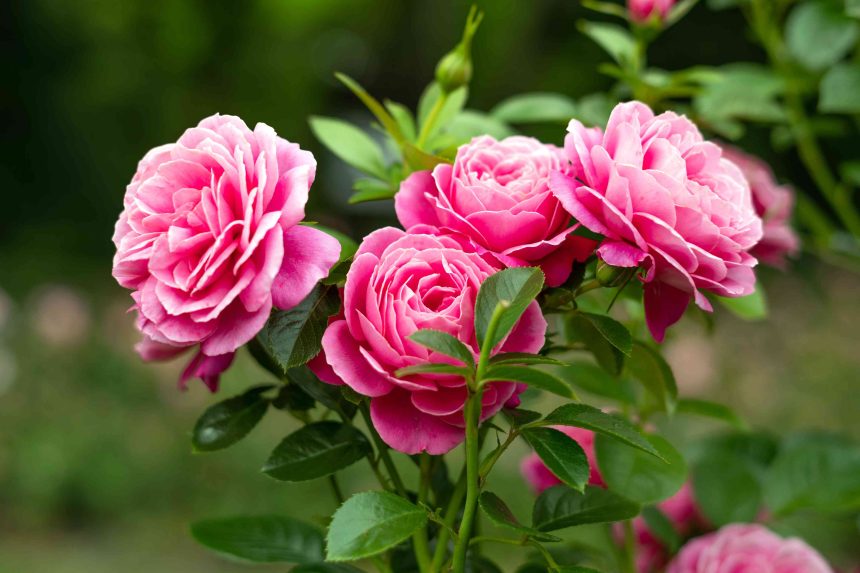Pruning plants is an essential part of the gardening process—proper pruning improves plants’ health, promotes growth, and boosts flowering and fruiting. However, timing is key when it comes to pruning your garden, and what you should prune depends on the season.
Trimming plants and flowers at the wrong time can damage them and cause issues such as weakened growth, proneness to diseases, and even death. That’s not good for any aspiring gardener. Our experts reveal the best time to prune everything in your garden each season so you can have flourishing flowers, plants, and trees all year long.
What to Prune and Maintain During the Spring Season
Nathan Heinrich, horticulturist and botanical designer, says when you venture into your garden in the spring, you will want to assess each plant and follow the “3 Ds” rule to determine what needs to be pruned. The three “Ds” stand for “dead, damaged, and diseased,” and this rule applies to pruning shrubs, trees, and perennials.
“Any branches that have died, been damaged from wind or snow, or are diseased with blight, should be removed,” he says. He adds that you should always clean your clippers between pruning each plant and recommends dipping them in a weak water and bleach or alcohol solution so as not to spread diseases from plant to plant.
Always clean and disinfect clippers before you begin pruning and between plants to prevent spreading diseases.
Prune Blooming Plants, Shrubs, and Trees
Heinrich says a simple rule for pruning blooming plants is “don’t prune till they bloom,” except for roses and other summer blooming plants and perennials, which flower on “new season” growth. If you prune spring-blooming plants in the spring, you will be cutting off bloom buds that are just weeks from flowering. Your rose bushes should be pruned back aggressively in the early spring before they begin pushing out new buds.
Evergreen flowering shrubs like azaleas and gardenias should be pruned after they have bloomed, and you should prune evergreen shrubs in early spring before they send out their first flush of new growth. “After flowering, deciduous shrubs like hydrangeas, forsythia, and lilacs have bloomed, you should cut back up to 25% of the plant, leaving at least 75% remaining,” he advises. “Flowering trees like dogwood and saucer magnolia should only be lightly pruned for shape after they bloom.”
He says that the spring season is also the best time to prune your citrus trees, after they’ve finished fruiting. “They can be lightly pruned for shape,” Heinrich adds. “Make sure not to cut back too much foliage, which they need to protect them from the summer sun.”
Prune Perennials, Woody Plants, and Ornamental Grasses
Spring is prime time for pruning perennials, woody plants, and ornamental grasses. “Prune woody herbs like sage or thyme in early spring as new growth begins, trimming them back to remove dead or damaged stems and to shape the plant,” says Rebecca Sears, CMO and resident green thumb at Ferry-Morse.
She explains that this encourages fresh, tender growth, which is more desirable for culinary use, as over the winter, cold weather can cause damage to the plant. “Avoid cutting into old-but-living wood,” she adds. “This can hinder regrowth.”
You should also remove dead leaves and twigs when pruning perennials. It’s best to leave 6-inch-long branches on your perennials that have died down to the ground over winter so you don’t accidentally step on them and forget they’re there or mistake them for weeds.
As far as pruning ornamental grasses, Heinrich says that you should not cut them back until spring because they add an architectural feature to your landscape during the winter months. They also provide food and shelter for birds and critters and insulate the grasses’ roots and crowns from severe cold.
What to Prune and Maintain During the Summer Season
Summer is the season when the least pruning is required. “The primary focus for gardeners in the summer is to cut back spent or dead flowers,” Heinrich explains. “This process, called ‘deadheading,’ is done for two main reasons—to encourage new and repeat blooms while keeping your garden looking tidy.”
According to Heinrich, you never want to do heavy pruning in the summer for several reasons: First, plants that are planted in full sun can suffer from sunburn if their previously shaded branches are abruptly exposed to scorching summer sun. Second, when you prune during the summer months, you can stunt the growth of many plants that are in the process of forming buds for the following year.
Lightly Prune Plants, Vines, and Deadhead Flowers
While summer is not the best time to prune most plants, a few require some tending throughout the season. Heinrich says that fast-growing vines such as wisteria, which need to be lightly shaped, are the exception to the “nearly no pruning in summer” rule.
Gene Caballero, expert gardener and co-founder at GreenPal says that pruning spent flowers from perennials and roses helps to prolong their blooming periods. “Eliminate suckers—which are the small shoots that develop in the leaf axils between the stem and branches—on fruit trees while performing light trimming on hedges to keep their form,” he advises. “Do not perform heavy pruning during periods of extreme heat to minimize stress on plants.”
Tomatoes should be pruned early to mid-summer by regularly removing the suckers. This practice directs the plant’s energy toward fruit production, resulting in larger tomatoes. “Additionally, trimming lower leaves can improve air circulation and reduce the risk of fungal diseases, like blight and powdery mildew, which thrive in humid conditions in the summertime,” Sears explains.
What to Prune and Maintain During the Fall Season
While you are able to prune your garden during the fall season, you need to make sure you time it right. “Many gardeners make the mistake of doing heavy pruning in the fall,” Heinrich cautions. “Any fall pruning should be done late in the fall because early pruning on most plants will encourage a flush of new growth.” The problem with this is that this new tender growth is not hardened off and resistant enough to survive the first frosts of autumn.
Prune Various Vegetable Plants and Evergreens
According to Sears, fall is the best time to prune certain types of vegetables, such as asparagus and Swiss chard. “Asparagus should be pruned after the first frost of fall,” she recommends. “Once the foliage turns brown and dies back due to frost, cut the asparagus ferns down to about 2 inches above the ground.”
This practice helps prevent pests and diseases from overwintering in the debris and prepares the bed for the next growing season. In addition, asparagus ferns collect energy for the crown and roots during the growing season, and by fall, the plants have stored enough energy for next year’s growth, making it safe to cut them back.
She says that Swiss chard should be pruned after the first hard frost. Remove all the dead and decaying leaves, cutting them back to the ground. Swiss chard is a biennial, meaning it grows for two seasons before going to seed. In warmer climates, pruning in fall allows the plant to continue producing fresh leaves throughout winter.
The cooler season is also the best time to shape and lightly prune evergreen trees and shrubs. “Fall pruning involves the removal of dead or diseased branches from trees and shrubs to prevent damage during winter,” Caballero says. “Shape evergreens gently before winter arrives but refrain from making substantial cuts.”
Light shaping on overgrown evergreen plants can be done in early fall, but you should keep your pruning to a bare minimum, Heinrich instructs.
Lightly Prune Fruit Trees and Perennials
Many fruit trees, such as apples, can be lightly pruned after they have fruited in the fall. “You want to ensure only to prune off growth from the current season, not cut off any of the older wood,” Heinrich explains.
You can also prune perennials, like hostas and daylilies, back when they enter their dormant phase. Do not prune plants that bloom in spring because you risk eliminating the buds for next year’s growth.
What to Prune and Maintain During the Winter Season
Winter is one of the best times to prune everything in your garden because most plants and trees are dormant. “Mid to late winter, when your plants are resting, is the time for some of the year’s most aggressive pruning,” Heinrich says. “Just make sure never to cut back more than a third of the plant’s overall mass.”
Prune Deciduous Fruit Trees, Evergreens, and Shrubs
Deciduous fruit trees and other trees that drop their leaves in the fall can be pruned in the winter months without shocking or disturbing them. “In the same way, we wouldn’t want to be operated on without anesthesia, plants also prefer to be asleep when they are being pruned,” Heinrich. Grapes, cherries, peaches, almonds, and walnuts are all examples of trees that should be pruned in the winter.
It is also the best time to remove any growth or branches on dead trees and shrubs, especially evergreens.
If you are unsure if a branch is actually dead, you can scratch a section of the branch with a butter knife or even your fingernail. “If the bark is brown underneath the surface, that means the plant is dead,” Heinrich says. “If there is green beneath the surface, there is still life in the branch.”
Prune Perennials and Roses
Winter is another perfect time to prune your perennials and roses. According to Caballero, you should prune them before new growth develops, and avoid pruning spring bloomers because their flower buds will be removed. “Pruning during winter helps plants develop strong and robust growth when spring arrives,” he says.
Prune various perennial flowers, such as coneflowers, during the winter season. “After a hard frost, coneflowers die back, leaving behind dry, brittle stems,” she explains. “Pruning in the winter allows the plant to focus energy on producing fresh, healthy growth when the weather warms up and helps clean up the garden in time for spring.” You should cut the stems down to 2 to 3 inches above ground to protect the crown from frost.
A key tip for knowing when the best time to prune your garden is to know your growing zone. “Knowing your growing zone is very important—spring on the West Coast is very different from spring on the East Coast,” Heinrich says. “There can sometimes be almost three months difference in when ‘spring’ starts in different locations.”
Use the USDA growing zone map to determine your zone, and follow these expert tips to ensure you prune your garden at the proper time.








